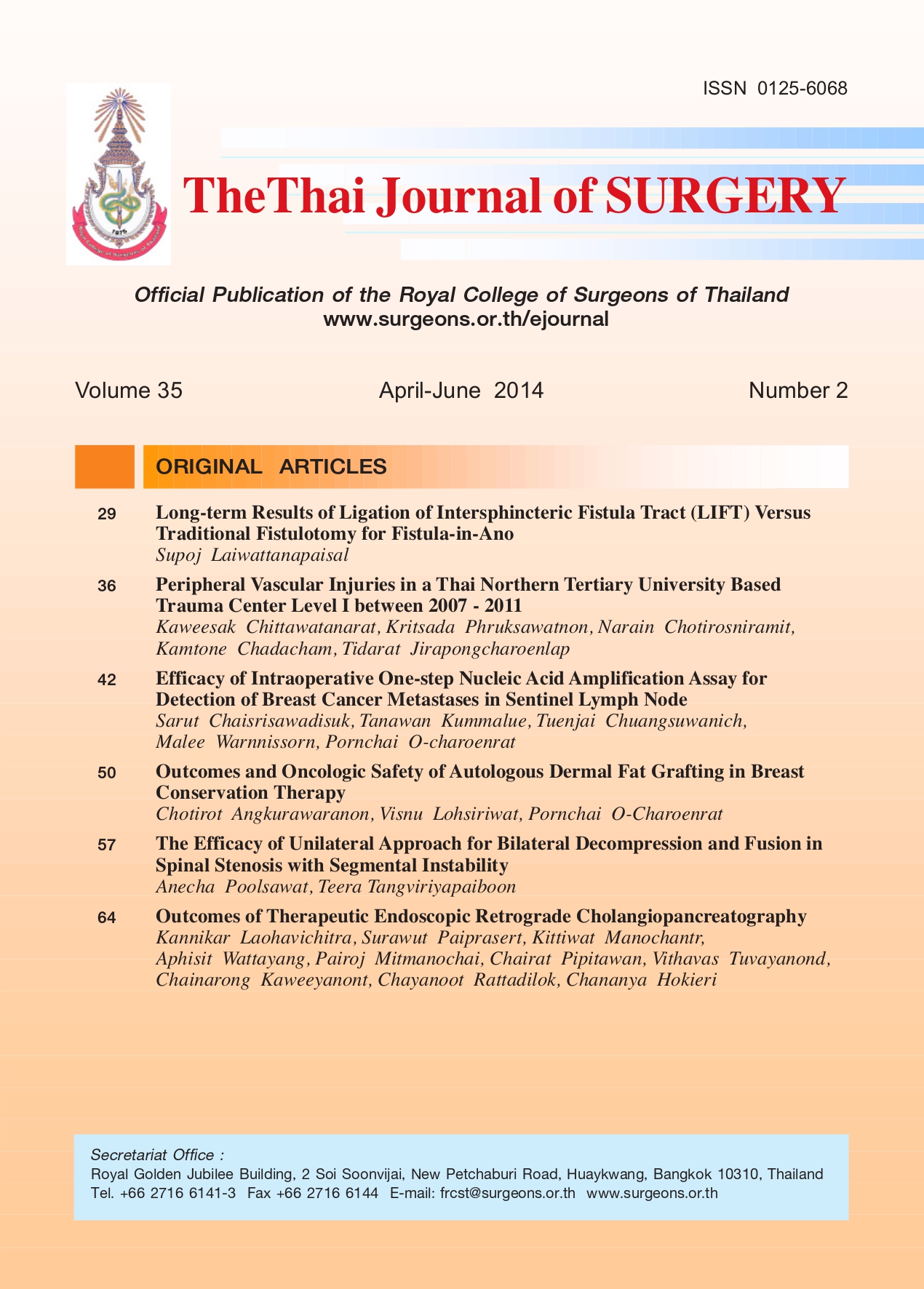Peripheral Vascular Injuries in a Thai Northern Tertiary University Based Trauma Center Level I between 2007 - 2011
Keywords:
Amputation, fasciotomy, Mangled Extremity Severity Score, peripheral vascular injury, popliteal artery injuryAbstract
Background: Peripheral vascular injury (PVI) is commonly associated with major trauma especially orthopedicsinjury. However, detailed descriptive data in Thailand especially in the Northern region were not available.
Objective: To describe the PVI over a five-year experience in our institute between 2007 and 2011after trauma
team was organized.
Methods: All of the PVI records during January 2007 - September 2011 were retrieved from the hospital
database. Injury characteristics, time to surgery, severity scoring and operation types were recorded and analyzed.
Results: A total of 176 injured patients were included in this study. The median occurrence of injury was 35 cases
per year (range 23 - 51 cases). Male was predominant gender (87.5%). Median age (Interquartile range, IQR) was 30
(21 - 43) years. Lower extrimity PVI was occurred higher than upper extremities PVI (59.1% vs. 40.9%). The most
common injury sites of upper extremity and lower extremity were radial arteries (12.5%) and popliteal arteries (26.7%)
respectively. Of these, 47% underwent vascular repair with conduits (44.3% with reverse saphenous vein graft (RSVG),
2.8% with synthetic PTFE graft) and 29% were repaired without conduit. The amputation rate was 15.3% with median
(IQR) of Mangled Extremity Severity Score (MESS) was 7 (7-8) and significant higher than non amputation group
(p<0.001). Fasciotomy rate was 6.8%. Significant risk factors of amputation were female (p=0.013), MESS score
(p<0.001), skeletal and soft tissue score (p<0.001), limb ischemic score (p<0.001), shock score (p<0.001), lower
extremity injury (p=0.014), blunt injury (p=0.011), popliteal artery injury (p=0.018), associated nerve (p=0.006), and
associated bone injury (p=0.015).
Conclusion: PVI is frequently found injury in the Northern Tertiary University-based hospital. Lower extremity
PVI occurred higher than upper extremity PVI. Female gender, MESS score and its components, blunt injury type, sites
of injury of lower extremity and popliteal, associated nerve and bone injuries were associated with the risk of
amputation.
References
Objective criteria accurately predict amputation following
lower extremity trauma. J Trauma 1990;30:568-72.
2. Rerkasem K, Arworn S, Thepmalai K. Prognostic factors of leg
amputation in patients with vascular injury: a systematic
review. Int J Low Extrem Wounds 2006;5:78-82.
3. Boutonnet M, Pasquier P, Jault P, Pierret C, Tourtier JP. Specific
patterns around the mangled extremity severity score in blastrelated
limb injuries. J Trauma 2011;71:785.
4. Prichayudh S, Verananvattna A, Sriussadaporn S, et al.
Management of upper extremity vascular injury: outcome
related to the Mangled Extremity Severity Score. World J Surg
2009;33:857-63.
5. Chittawatanarat K, Ditsatham C, Chotirosniramit N,
Chandacham K, Jirapongcharoenlap T, Traisathit P.
Characters of mortality and time series analysis in thoracic
injury before and after rapid response trauma team
establishment. Thai J Surg 2012;33:7-12.
6. Chittawatanarat K, Ditsatham C, Chandacham K,
Jirapongcharoenlap T, Chotirosniramit N. Effects of rapid
response trauma team in thoracic injuries in northern trauma
center level I. J Med Assoc Thai 2013;96:1319-25.
7. McNamara MG, Heckman JD, Corley FG. Severe open
fractures of the lower extremity: a retrospective evaluation of
the Mangled Extremity Severity Score (MESS). J Orthop Trauma
1994;8:81-7.
8. Robertson PA. Prediction of amputation after severe lower
limb trauma. J Bone Joint Surg Br 1991;73:816-8.
9. Rush RM, Jr., Kjorstad R, Starnes BW, Arrington E, Devine JD,
Andersen CA. Application of the Mangled Extremity Severity
Score in a combat setting. Mil Med 2007;172:777-81.
10. Slauterbeck JR, Britton C, Moneim MS, Clevenger FW. Mangled
extremity severity score: an accurate guide to treatment of
the severely injured upper extremity. J Orthop Trauma 1994;
8:282-5.
11. Sheean AJ, Krueger CA, Napierala MA, et al. Evaluation of the
Mangled Extremity Severity Score (MESS) in Combat Related
Type III Tibia Fracture. J Orthop Trauma 2013.
12. Togawa S, Yamami N, Nakayama H, Mano Y, Ikegami K, Ozeki
S. The validity of the mangled extremity severity score in the
assessment of upper limb injuries. J Bone Joint Surg Br 2005;
87:1516-9.
Downloads
Published
How to Cite
Issue
Section
License
Articles must be contributed solely to The Thai Journal of Surgery and when published become the property of the Royal College of Surgeons of Thailand. The Royal College of Surgeons of Thailand reserves copyright on all published materials and such materials may not be reproduced in any form without the written permission.



